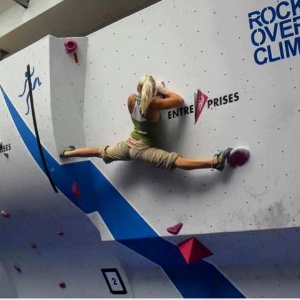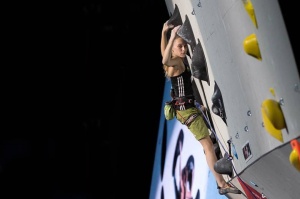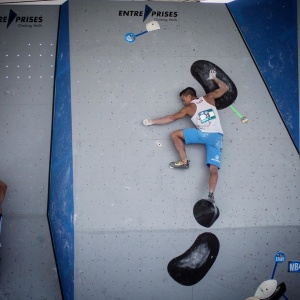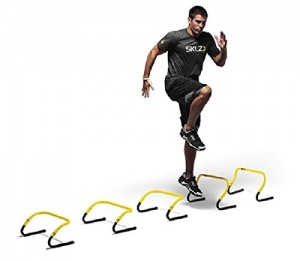The Importance of Stability

Classic shot of Leah Crane in action, displaying amazing mobility, but also stability.
Climbing is obsessed with mobility; Social Media is flooded with pictures of top climbers in crazy positions and equally crazy training methods to achieve them. Certainly to perform at International level you need to be able to achieve incredible feats of hip mobility. But these photos of insane positions hide what is happening under the bonnet, what the muscles are doing to support these movements. As coaches and athletes we need to look at what our own bodies are designed to do, we aren’t all made to do the splits and as much as more mobility is a good thing to much can be an injury waiting to happen. I aim to look into the importance of stability and why we need to be more aware of it in climbing.
The Mobility / Stability paradox
Joint mobility is made up of the flexibility of the muscle, the soft tissue of the joint and often the action of muscles around the joint. An unstable joint is at risk of injury just as much as a tight joint is being pushed beyond is range of motion. Movement without stability is an injury waiting to happen. We also need a greater understanding of the mechanisms of the body, not all joints are meant to be highly mobile. Tightness in one joint may lead to the body trying to achieve greater range of motion in another with reciprocal effects throughout the body. As a coach and athlete we need to look at the bigger picture, start at the bottom and work up, can the ankles move, hips, thoracic spine, shoulders. Some joints such as the knee and lumbar spine aren’t meant to have a huge multi directional range of motion. If they are our body may compensate with more stability in joints we actually want moving freely.

Janja Garnbret: Incredible shoulder range of motion matched with equally incredible shoulder stability and strength. Photo Luka Fonda
In sports such as climbing we’re interested in our active range of motion not passive! It’s no use being able to do the splits if we can’t move in that position. We need to watch our athletes, run, jump, hop and climb. If we can’t land a hop with stability what makes you think the climber can stabilise during a deep rock over? If we can’t do a pistol squat we wont’ be able to stand up with no hands on a single leg. If we can’t stabilise the shoulders during the bottom of a chin-up how can we safely hope to engage the shoulder during a dynamic catch? We need to understand the relationship between stability and movement. All of these can be easily assessed by a knowledgeable coach during warm-ups and training.
The Relationship between Stability and Technique
I recently read a great quote which I wish I could find again ‘The greater the level of technique in a sport the great the level of strength required to support it’!

Sean McColl showing amazing hip control at the Vail World Cup. Photo credit Sendaholic
I know you’re probably all screaming at your screen that climbing is all about the movement. But unless our body can stabilise and produce adequate force in those positions we will won’t be able to perform those techniques. Think of other sports that have a high level of technique, figure skating, to get those skills figure skaters glutes are hugely strong to offer stability and control to the hips. In throwing sports shoulders are strong and stable to control the movement. It’s no different in climbing.
But the relationship goes deeper than that. When climbing we require extensive motor programs of the techniques engrained in our system to allow us to move freely. We need the muscles and CNS to regulate the movement in an autonomous manner with limited input from the Brain beyond the intent of the movement. These programs need to be installed through technique coaching and training. One of the key parts in our body developing autonomous motor programs is stability. I body naturally chooses movements with more Attractors (stability) than Fluctuators (unstable position) in them. Perceiving the Fluctuators as an injury risk, more so when our body looks to intrinsic feedback to adjust and refine motor programs it will prioritise feedback from Attractors over Fluctuators.
If we are continuously pushing mobility without the corresponding stability training are body is going to shy away from those unstable positions and techniques that require them.
What can we do
We need to coach what we see. We know that we need amazing hip mobility to make it to the top of climbing. Our approach needs to be systematic and long term. Build and change bit by bit. If we’ve got very good mobility then maintain this and build strength, if we’ve got strength then build mobility. But it isn’t one size fits all!

Get them running, jumping, hopping, sprinting!
Build athletes first, get them running, jumping, changing direction, stopping, starting. Introduce them to the basics of strength training, squats, deadlifts, lunges, pushing, pulling. This movement literacy can then be built on later.
Start off with bilateral exercises, regress the exercise where necessary then progress through standard exercise variation till they are ready for unilateral work. Get them exerting force through those joints! Put them under load and make them robust. But fundamentally get them moving.
Use Yoga where appropriate it works fantastically when combined with a good strength and conditioning program but in my view fails when used in isolation.
Above all get a coach who is trained in Strength and Conditioning, one that can progress and regress exercises depending on ability. One that can fully assess your movement and design a program around this.